|
Vocapedia >
War >
Casualties > Burials
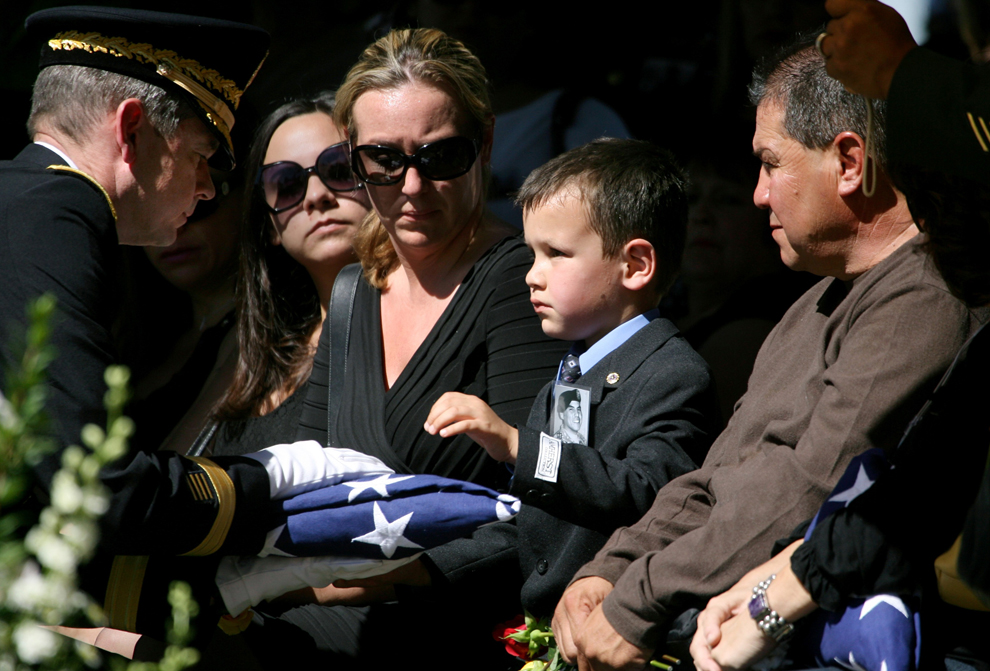
MacAidan Gallegos, 5,
receives a flag from Brigadier General Sean MacFarland
as Amanda Doyle,
MacAidan's mother,
watches during the funeral services
for Army Sgt. Justin Gallegos
at Evergreen
Cemetery in Tucson, Ariz.
Thursday, Oct. 15, 2009.
The Department of Defense says
Gallegos was one of eight U.S. soldiers killed
in
Afghanistan Saturday, Oct. 3, 2009
during a fight with insurgents
in a remote area near the Pakistan border.
Photograph:
AP Photo/Arizona Daily Star, Mamta Popat
Boston Globe > Big Picture
Afghanistan, October, 2009
October 26, 2009
http://archive.boston.com/bigpicture/2009/10/
afghanistan_october_2009.html
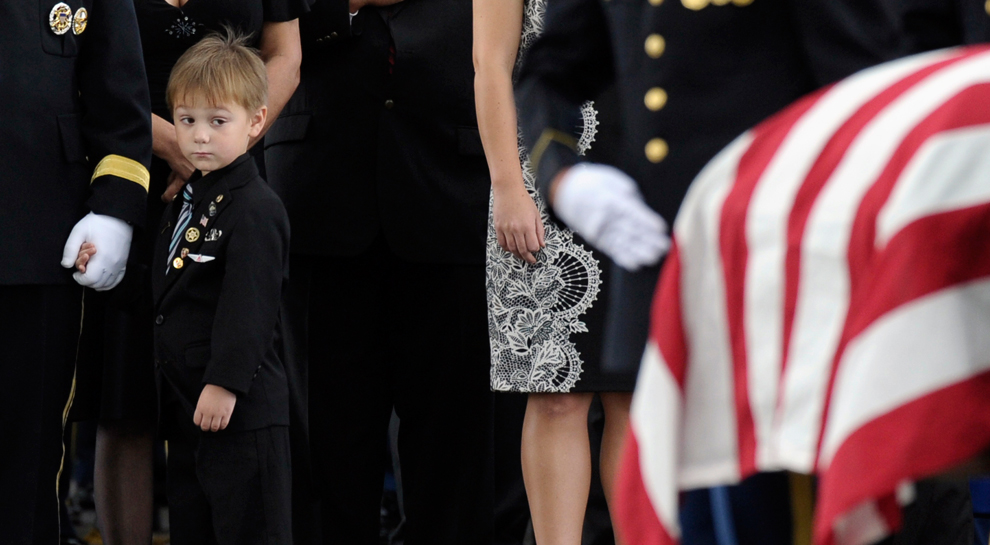
Kaden Bowden,
son of U.S. Army Staff Sgt. Joshua J. Bowden,
looks at the casket for his father
during burial services for
Staff Sgt. Bowden
at Arlington National Cemetery in Arlington, Va., Sept. 27.
Bowden was from Villa Rica, Ga., and died on Aug. 31,
from injuries sustained while serving in Afghanistan.
Photograph: Susan Walsh
Associated Press
Boston Globe > Big Picture
Daily life: September 2013
October 2, 2013
http://archive.boston.com/bigpicture/2013/10/
daily_life_august_2013_1.html
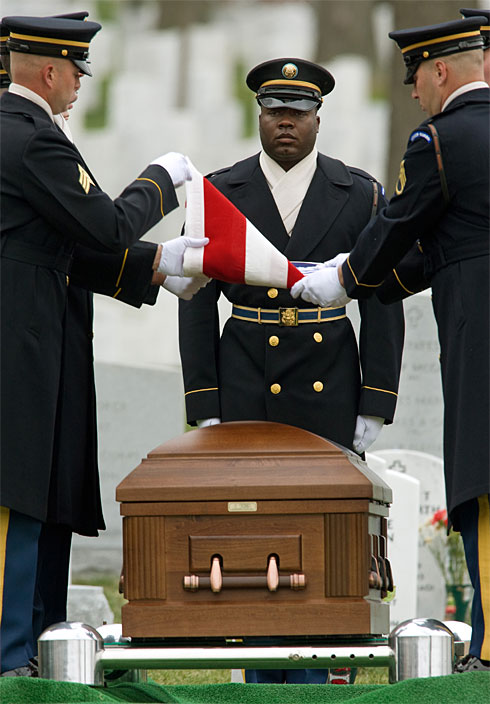
Killed in Iraq:
A U.S. Army Honor Guard casket team folds a U.S. flag
over the casket of Army Cpl. Luke Runyan
during funeral services
at Arlington National Cemetery
in Virginia on March 10.
Photograph:
Paul J. Richards
AFP/Getty Images
Names of the dead mean more than numbers
By Rick Hampson
USA TODAY
20 March 2008
https://usatoday30.usatoday.com/news/nation/2008-03-20-
iraq-4000-deaths-side_N.htm
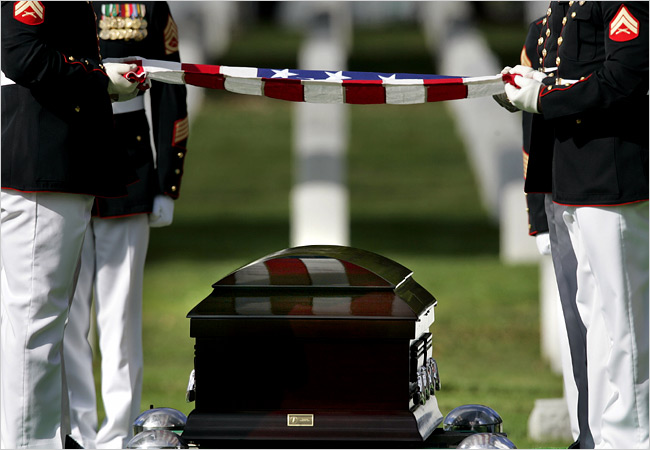
Sergeant Walsh, of Cuyahoga Falls, Ohio,
was
wounded in Iraq and later died
at Walter Reed Army Medical Center in Washington.
Photograph: Doug Mills
A Most Violent Month, and Many Final Farewells
NYT
30 October 2006
https://www.nytimes.com/2006/10/30/
us/30arlingtonblurb.html
France > Aisne-Marne American Cemetery, near Belleau
USA
https://www.nytimes.com/2014/08/24/
travel/100-years-of-gratitude.html
at Arlington National Cemetery in Virginia
USA
https://arlingtoncemetery.org/
https://www.npr.org/2022/05/30/
1101997394/memorial-day-arlington-gold-star-family-commemorates
https://www.nytimes.com/2018/05/28/
us/arlington-cemetery-veterans.html
http://www.boston.com/bigpicture/2010/05/afghanistan_may_2010.html
http://www.usatoday.com/news/nation/2008-03-20-iraq-4000-deaths-side_N.htm
USA > The Tomb of
the Unknowns
at Arlington National Cemetery in Arlington, Va. /
the
Tomb of the Unknown Soldier
http://www.arlingtoncemetery.org/ceremonies/sentinelsotu.html
- broken link
Belgium > Tyne Cot Cemetery
"Tyne Cot cemetery
is situated to northwest
of
the Belgian town of Ypres.
Tyne Cot
is the biggest
of the British war graves cemeteries.
It contains nearly 12,000 graves
and has a memorial to over 35,000 men
who are recorded as missing
and have no known grave."
https://www.firstworldwar.com/today/tynecot.htm
http://www.greatwar.co.uk/westfront/ypsalient/cemeteries/tynecot.htm
http://www.nytimes.com/2014/06/27/world/europe/
world-war-i-brought-fundamental-changes-to-the-world.html
"death gratuity"
USA
The death gratuity
is a one-time non-taxable payment
to help surviving family members
deal with the financial hardships
that
accompany
the loss of a servicemember
http://www.nytimes.com/2008/03/22/nyregion/22benefits.html
http://www.nytimes.com/2005/01/26/nyregion/26gratuity.html
bury
UK
https://www.theguardian.com/uk/2007/apr/29/
afghanistan.military1
burial USA
http://www.usatoday.com/news/nation/2008-03-20-iraq-4000-deaths-side_N.htm
be laid to rest
UK
https://www.theguardian.com/world/2013/jul/17/
british-airmen-shot-down-war-italy-raikes
Rest In Peace
(R.I.P.)
Wootton Bassett, Wiltshire
UK
http://www.guardian.co.uk/uk/2010/feb/25/wootton-bassett-audrey-gillan
http://www.guardian.co.uk/media/2009/dec/03/question-time-afghanistan-wootton-basset
http://www.guardian.co.uk/uk/2009/nov/20/wootton-bassett-100th-repatriation-soldiers
http://www.guardian.co.uk/uk/2009/jul/10/soldiers-deaths-afghanistan-wootton
funeral USA
http://www.usatoday.com/news/nation/2008-03-20-iraq-4000-deaths-side_N.htm
horse-drawn caisson USA
http://www.usatoday.com/news/nation/2008-03-20-iraq-4000-deaths-side_N.htm
casket USA
http://www.usatoday.com/news/nation/2008-03-20-iraq-4000-deaths-side_N.htm
flag USA
http://www.usatoday.com/news/nation/2008-03-20-iraq-4000-deaths-side_N.htm
taps USA
http://www.npr.org/sections/thetwo-way/2015/07/09/421573285/
in-photos-nearly-a-century-after-death-union-soldier-gets-a-proper-burial
https://www.west-point.org/taps/Taps.html
https://www.arlingtoncemetery.net/taps.htm
"Taps are sounded,
lights are out,
the soldier
sleeps."
play taps
USA
sound taps
http://en.wikipedia.org/wiki/Taps
last post UK
http://www.guardian.co.uk/world/2009/jul/30/henry-allingham-funeral-war-veteran
http://www.guardian.co.uk/world/2008/nov/09/last-post-ypres-menin-remembrance-day
military trappings
a day of national mourning
mourn
USA
http://www.usatoday.com/news/nation/2007-04-26-fort-bragg-mourns_N.htm
remains
http://www.nytimes.com/2011/11/10/us/dover-mortuary-burned-and-dumped-troop-remains-in-landfill.html
http://www.nytimes.com/2011/11/09/us/senior-air-force-officials-disciplined-over-handling-of-human-remains.html
https://www.reuters.com/article/domesticNews/idUSN30414892
20080331
coffin
salute the flag draped
coffin of...
USA
rifle salute
USA
at the Rhode Island Veterans Cemetery in Exeter
USA
war graves
eulogies UK
http://www.guardian.co.uk/news/defence-and-security-blog/2011/jul/06/
british-casualties-afghanistan-scott-mclaren
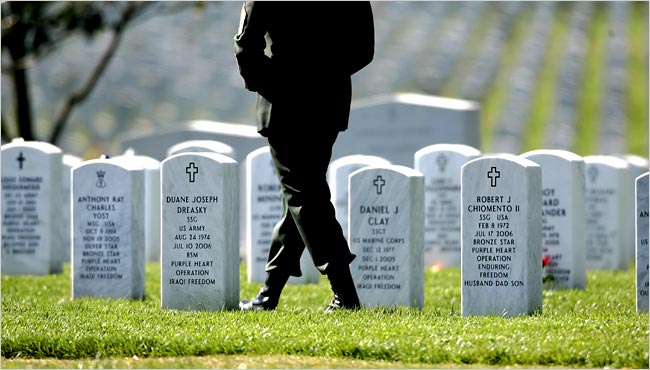
An Army
soldier last week at Arlington
walking past graves of troops
who have died in
Iraq and Afghanistan.
Photograph: Doug Mills
The New York Times
A Most Violent Month, and Many Final
Farewells
NYT
30 October 2006
https://www.nytimes.com/2006/10/30/
us/30arlingtonblurb.html
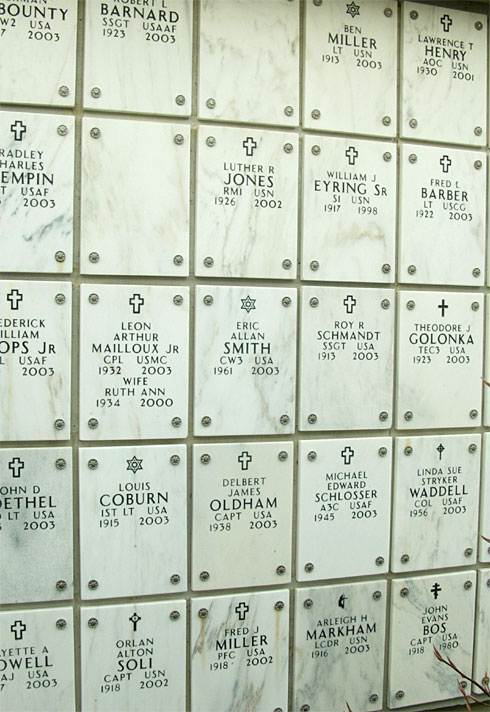
This is a
vault in a columbarium at Arlington National Cemetery.
Columbariums, which hold urns containing ashes of the dead,
are part of a growing trend of churches that are reverting back to
the old church graveyard tradition in a modern way.
Photograph: Tim
Dillon
USA TODAY
Churches
apply graveyard tradition to ashes
UT
27 May 2007
https://usatoday30.usatoday.com/news/religion/2007-05-27-
columbaria_N.htm
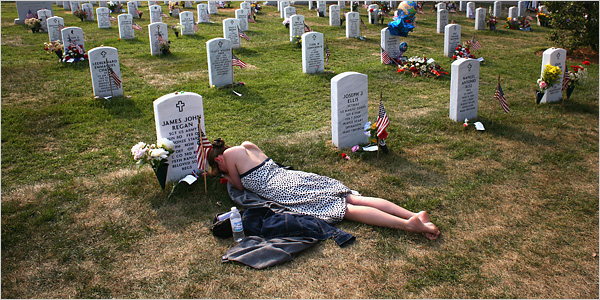
Mary McHugh
visited the grave of her fiancé, Sgt. James J. Regan,
who was
killed in Iraq in February.
He is buried in the new Section 60
of Arlington National Cemetery
for those
killed in Iraq and Afghanistan.
Photograph: John
Moore
Getty Images
Memorial Day
Photos: In Memoriam
No article
NYT
28 May 2007
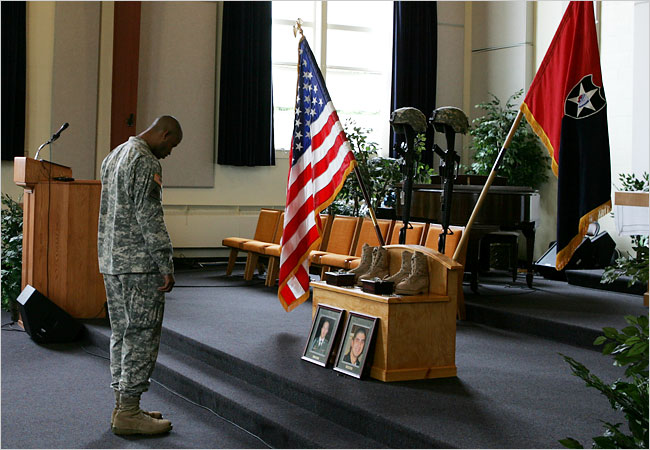
Friends,
comrades and family members
paid their respects to
Sgt. Joel Anthony Dahl
and Cpl. Victor Abraham Garcia,
both recently killed in
Iraq,
at a small chapel at Fort Lewis, Wash.
Photograph:
Kevin P. Casey
for The New York Times July 24, 2007
On Base, a Plea to Give Each Death Its Due
NYT 25 July 2007
https://www.nytimes.com/2007/07/25/
us/25funeral.html
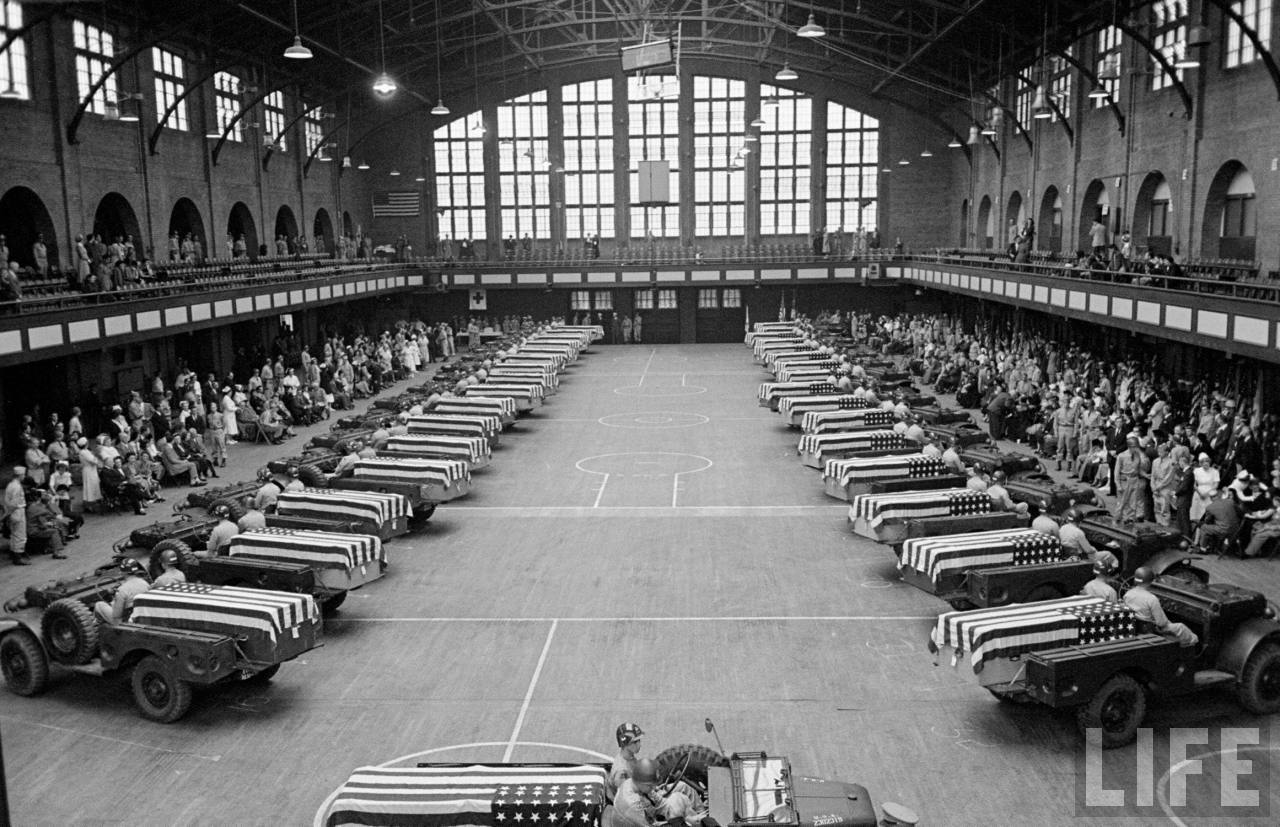
Burial
Date taken:
September 09, 1950
Photographer:
George Silk
Life Images
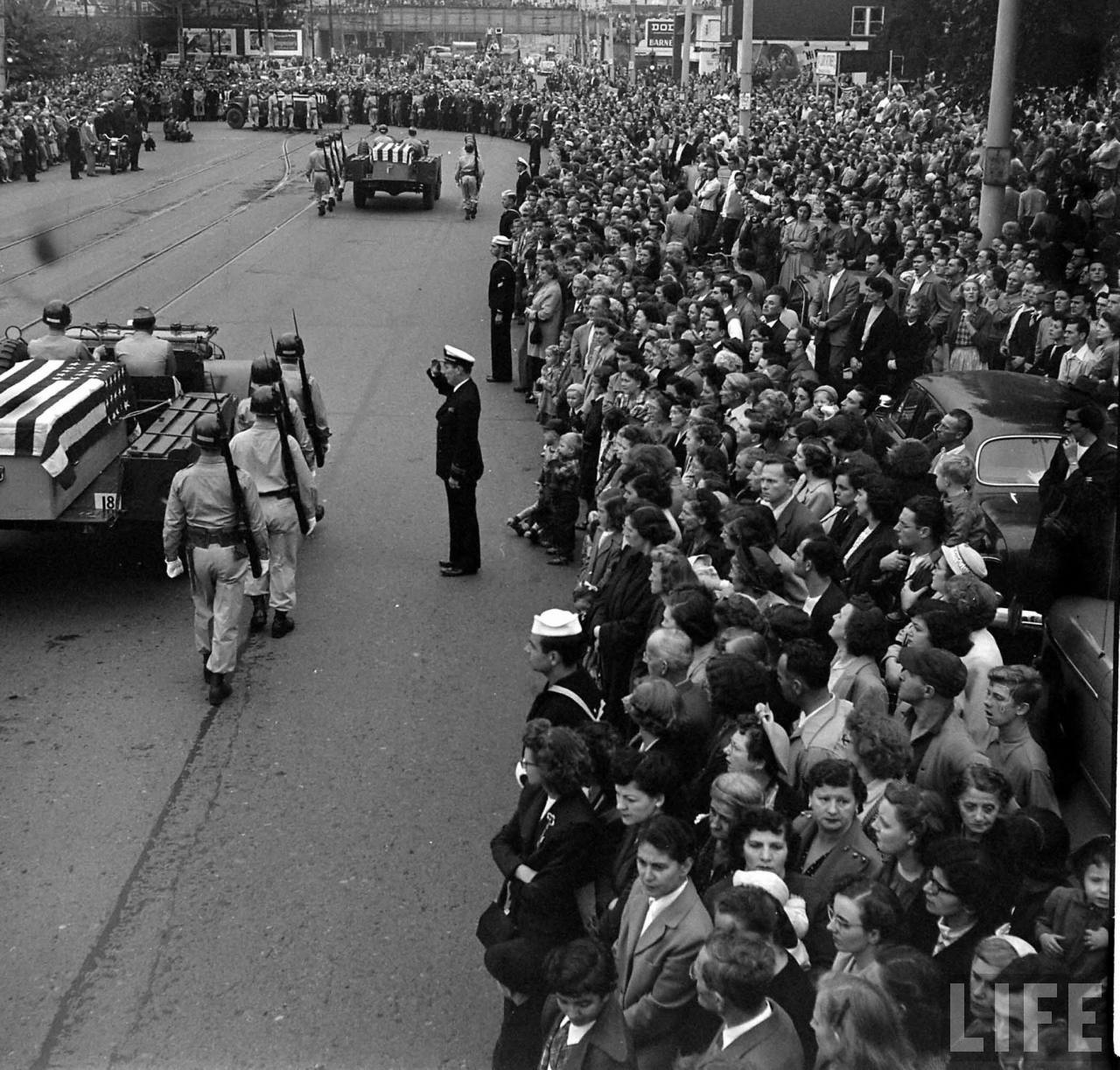
Burial
Date taken:
September 09, 1950
Photographer:
George Silk
Life Images
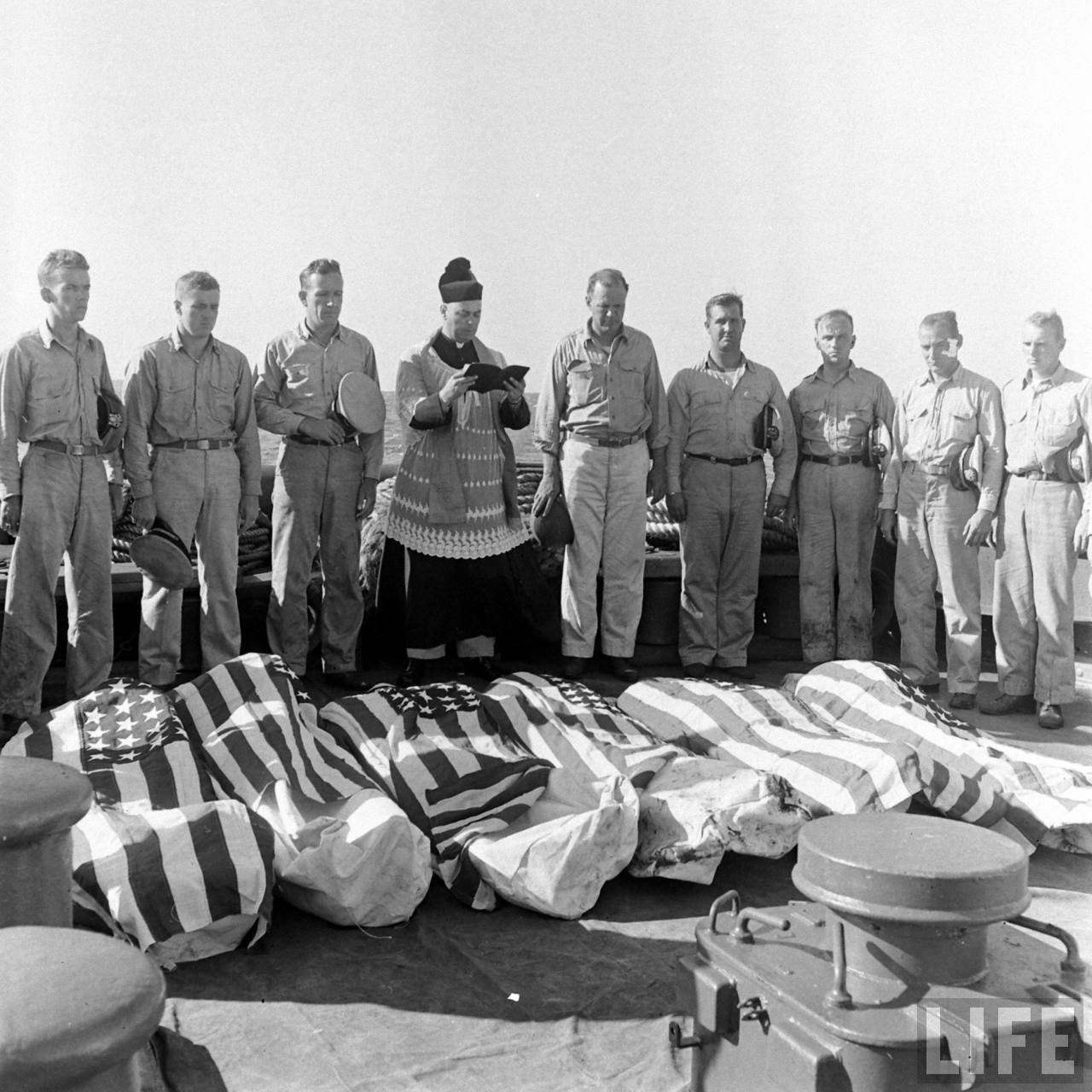
Lci Burial
At Sea
Date taken:
March 1944
Photographer: George Strock
Life Images
Corpus of news articles
War > Casualties > Burials
At Arlington,
Obama Pays Tribute to US War Dead
September 10, 2011
The New York Times
By THE ASSOCIATED PRESS
ARLINGTON, Va. (AP) — President Barack Obama and first lady
Michele Obama have visited Arlington National Cemetery where they paid tribute
to members of the military killed in the wars in Iraq and Afghanistan.
One day before the 10th anniversary of the Sept. 11 attacks, the Obamas made a
pilgrimage to Section 60 of the cemetery. The White House says that's the burial
ground for military personnel killed in those two wars. Those conflicts have
claimed 6,213 military personnel.
At one gravesite, the Obamas stopped to talk with members of a family who
appeared to be visiting a grave. The Obamas chatted a few minutes, posed for
pictures and gave out handshakes and hugs.
Then the Obamas, hand in hand, strolled along one of the rows between identical
white tombstones, pausing at some markers.
At Arlington, Obama Pays
Tribute to US War Dead,
NYT,
10.9.2011,
http://www.nytimes.com/aponline/2011/09/10/
us/AP-US-Sept-11-Obama-Arlington.html - broken link
On Base,
a Plea to
Give Each Death Its Due
July 25, 2007
The New York Times
By WILLIAM YARDLEY
FORT LEWIS,
Wash. — Twenty soldiers deployed to Iraq from this Army base were killed in May,
a monthly high. That same month, the base announced a change in how it would
honor its dead: instead of units holding services after each death, they would
be held collectively once a month.
The anger and hurt were immediate. Soldiers’ families and veterans protested the
change as cold and logistics-driven. Critics online said the military was trying
to repress bad news about deaths. By mid-June, the base had delayed the plan.
[Its commander, Lt. Gen. Charles H. Jacoby, was expected to decide Wednesday
whether to go through with it.]
“If I lost my husband at the beginning of the month, what do you do, wait until
the end of the month?” asked Toni Shanyfelt, who said her husband was serving
one of multiple tours in Iraq. “I don’t know if it’s more convenient for them,
or what, but that’s insane.”
Military historians and scholars say the proposal and its fallout highlight the
tender questions facing the armed forces as casualties in Iraq and Afghanistan
mount, and some soldiers and their families come to expect more from military
bases than in past conflicts.
During Vietnam and Korea, the historians say, many bases were places for
training soldiers and shipping them out, rarely to see them return, with
memorial services uncommon. Now, in the age of the all-volunteer force, the base
has become the center of community. The Army and other branches have fostered
the idea that military service is as much about education, job training and
belonging to a community as national defense.
“It wasn’t considered the Army’s business in any of the other wars to conduct
these services,” said Alan H. Archambault, director of the Fort Lewis Military
Museum, which is supported by the Army. “It was the hometowns of the soldiers
that died that had these. Now I think the Army bases are trying to be the
hometowns.”
Army officials said the idea to hold monthly services reflected a need to find
balance between honoring the dead and the practical reality that the services
take time to plan, including things like coordinating rifle salutes and
arranging receptions for family members who attend.
“As much as we would like to think otherwise, I am afraid that with the number
of soldiers we now have in harm’s way, our losses will preclude us from
continuing to do individual memorial ceremonies,” Brig. Gen. William Troy, who
was the interim commander at Fort Lewis at the time, wrote in an e-mail message
announcing the policy in May.
The Army also emphasizes that the ceremonies held on bases are in addition to
those held by the soldier’s unit overseas as well as private family services,
which usually include military honor guards. Those services would not be
affected if Fort Lewis moved to a monthly schedule.
Fort Lewis, the third-largest Army base in the nation, has about 10,000 of its
28,000 soldiers deployed overseas, a majority of them in Stryker brigades
trained specially for urban combat. Several other major bases, including Fort
Hood in Texas, the largest, already hold services monthly. Some hold them even
less frequently.
“There is no Army-wide policy to have any memorial services,” a spokeswoman for
the Army, Maj. Cheryl Phillips, said in an e-mail message. “Commanders make the
call. Several installations have conducted services for each individual soldier
and now have begun to roll them into a quarterly service because, alas, the
casualty numbers are rising.”
At many bases, local elected officials attend the services. At Fort Hood, whose
First Cavalry Division has 19,000 soldiers overseas, many of these officials are
veterans with ties to the base or the Army.
“It really is important that we keep it scheduled and that these people all have
it on their calendars,” said Diane Battaglia, a spokeswoman for Fort Hood.
Ms. Battaglia said the monthly services helped bring families together, a point
also made by General Troy at Fort Lewis.
“I see this as a way of sharing the heavy burdens our spouses and rear
detachments bear, while giving our fallen warriors the respect they deserve,”
General Troy wrote in the e-mail message. “It will also give the families of the
fallen the opportunity to bond with one another, as they see others who share
their grief.”
Ms. Battaglia said the Fort Hood soldiers received individual eulogies at the
monthly services. “It has worked phenomenally well,” she said.
At Fort Lewis, however, tension has been evident; changing a ritual, especially
as the death toll is rising, strikes some as disrespectful.
“By reducing it to once a month, I think they’re taking away from us,” said
Staff Sgt. Jason Angelle. “Soldiers deserve individual honors.”
Sue Rothwell, who runs a diner popular among soldiers that is just outside the
main gate, said she had long opposed the war in Iraq but had recently made a
public point of honoring those who serve in it. Several weeks ago she started
putting the last names of soldiers who had died on the reader board outside the
restaurant, called Galloping Gertie’s, under the heading, “The numbers have
names.”
Ms. Rothwell said she opposed monthly services. “Individuals gave their lives,”
she said. “But if you have services just once a month, the other 29 days you
don’t have to think about it. Well, isn’t that convenient.”
For now, at least, those who die are eulogized as hometown heroes, either
individually or by division.
“We owe them the highest gratitude a nation can give,” Lt. Col. John Pettit, a
chaplain, said at a memorial service in July for two soldiers. Sgt. Joel A. Dahl
and Cpl. Victor A. Garcia were killed by small-arms fire in Iraq.
On Base, a Plea to Give Each Death Its Due, NYT, 25.7.2007,
http://www.nytimes.com/2007/07/25/us/25funeral.html
Called, Increasingly, to a Somber Duty:
Last Respects for the
Military’s Dead
May 5, 2007
The New York Times
By DAVID K. RANDALL
A gray Dodge Caravan with government plates stopped in a section of St.
Raymond’s Cemetery in the Bronx on Tuesday and three young soldiers in dress
blue uniforms stepped out. Specialist Rebecca Santana, 23, carried a black case
holding a ceremonial bugle. Staff Sgt. Noel Rodriguez, 26, and Specialist Ruben
Martinez, 23, walked toward a mound of fresh earth amid narrow rows of
well-tended graves. The three were there to serve as official Army
representatives at the funeral of a World War II veteran.
Sergeant Rodriguez and Specialists Santana and Martinez are members of the
Southern Section of the Honor Guard, a division of the New York Army National
Guard based at the Kingsbridge Armory in the Bronx that provides military honors
at military funerals in New York City, on Long Island and in southern
Westchester County.
The demand for their services is rising: On some days, details of two to seven
guards will serve at 30 or more military funerals.
“There is no end in sight for our job, unfortunately,” said Donald Roy, a former
master sergeant who is program director for the New York Military Forces Honor
Guard, which is responsible for handling military funerals statewide. Military
honor guards served at 9,136 funerals in New York State last year with members
of the Bronx guard serving at nearly 70 percent of them, Mr. Roy said
In many ways, the Bronx-based Honor Guard, which has 30 members, is a service
without politics, without medals and without heroics. Instead, it is part of a
solemn ritual that spans generations: On the same day, the Guard may serve at a
funeral for a soldier killed in Iraq and at one for a Korean War veteran.
The overwhelming majority of the military funerals, however, are for World War
II veterans, a generation that is dying nationwide at the rate of 1,600 per day,
according to military estimates. Mr. Roy said the number of funerals for World
War II veterans should peak in October 2008. “After that we’ll have a brief
slowdown until we reach Korea, and then it will pick back up again,” he said.
One reason for the large volume of work is a 2000 federal law requiring the
military to provide at least two soldiers for the funeral of any veteran whose
family requests the service. Since the law was enacted, the budget for the
statewide program has risen to $5.5 million from $700,000, Mr. Roy said.
For the soldiers who serve in the funeral details, the reasons for joining the
Honor Guard vary. For some it is patriotism. For others, it is also a reliable
part-time job that pays roughly $40 a day. And for others, it is a way to heal
the wounds of a continuing war.
When Staff Sgt. Melchiorre Chiarenza, 37, came back from Baghdad in 2006 after
serving with the 69th Infantry Division, commonly known as the Fighting 69th, he
could not leave the war behind. He said he saw 19 soldiers killed in action and
it was his job to identify their remains. “When I came home, they said I had
post-traumatic stress disorder, and I said ‘Yeah, that’s probably right,’ ” he
said. “The Honor Guard was therapy for me.”
Specialist Orlando Torres, 28, has served on the Honor Guard for almost four
years, and dreams of becoming a military chaplain. “I’m a Christian, and I
wanted to put my faith into service,” he said. “I pray a lot to get through this
job.”
Before Sgt. Ryan Comstock, 21, joined the Honor Guard, he nearly lost his older
brother, Ken, 25, an Army sergeant who was hit in the forehead by shrapnel in
2004 while driving a Humvee in Baghdad. Medics initially thought he would die,
but they were able to save him, and he was taken to Germany and then to Walter
Reed Army Medical Center in Washington, where a ceramic plate was inserted in
his forehead. All this happened in the same week Sergeant Comstock signed the
papers to join the service. Military officials went to his house in Glens Falls
and told him that he did not have to join, he said, but he thought not enlisting
would let his family and country down.
Partly because of his brother’s experiences, Sergeant Comstock said, funerals
for soldiers killed in action are the toughest. “It’s hard when you pick up the
casket and feel like there’s nothing inside of it,” he said. “You see their
pictures and they don’t look that much older than me, and you see their parents
and they don’t look much older than my parents.”
The emotional toll of serving on the Honor Guard is constant, Mr. Roy said.
Second Lt. Melvin Rodriguez, 27, said he sometimes finds it hard to maintain eye
contact with a dead veteran’s relative when handing over the flag. “You see all
of their emotions, and as soon as you start talking, they start crying,” he
said.
Sergeant Rodriguez, who is not related to Lieutenant Rodriguez, said he adds a
sentence offering his personal condolences to the official script Honor Guard
members say when presenting the flag.
Sergeant Comstock said his team members often spend time together outside work.
“You have to do things to blow off steam or else you’ll have kids in the mental
ward,” he said.
To serve on the Honor Guard, soldiers attend a weeklong training academy in
upstate New York where they learn the history of the State Honor Guard, which
mirrors the traditions of the Third Infantry Regiment, the unit responsible for
funerals at Arlington National Cemetery. Soldiers must also meet with a grief
counselor to talk about their role in military funerals and how to cope with
their work.
They also learn the rituals of a military funeral. For veterans who died with
less than 20 years of service, a three-person team folds a flag draped over the
coffin and presents it to the next of kin, and a soldier will sound taps on a
ceremonial bugle. For those with 20 years or more of service, four additional
soldiers are part of the detail and serve as a gun-salute party. And for
soldiers killed on active duty, a detail totaling 22 soldiers will also serve as
pallbearers and color guard, and will stand sentry over the coffin during a
wake.
On Tuesday night, a team of seven Honor Guard members enacted a mock funeral
service inside the 69th Regiment Armory in Manhattan as part of a presentation
for about 100 funeral home directors. Specialist Santana stood at a 45 degree
angle to a coffin, faced away from the crowd and sounded taps. Sgt. Comstock and
Specialist Torres were part of the gun-salute party, using M-14 rifles. Sergeant
Rodriguez and Specialist Martinez folded a flag, and Sergeant Rodriguez handed
it to a woman playing the role of next of kin.
Sergeant Rodriguez recited the same words he had said at the funeral earlier in
the day at St. Raymond’s Cemetery for the World War II veteran.
“As a representative of the United States Army, it is my high privilege to
present you this flag,” he said. “Let it be a symbol of the grateful
appreciation our nation feels for the distinguished service rendered to our
country and our flag by your loved one.”
Called, Increasingly, to
a Somber Duty:
Last Respects for the Military’s Dead, NYT, 5.5.2007,
http://www.nytimes.com/2007/05/05/nyregion/05guard.html
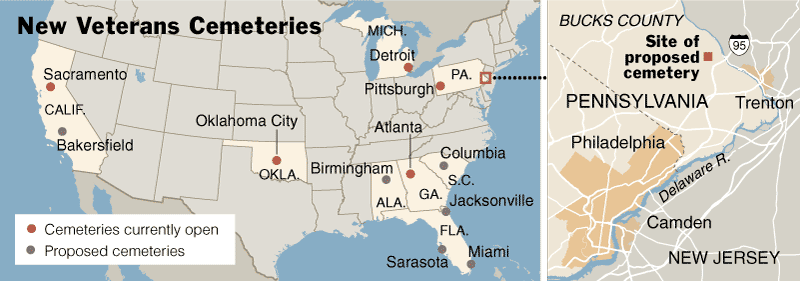
NYT
November 8, 200-
Veterans
Await a Resting Place That Is Truly Final
NYT 9.11.2006
http://www.nytimes.com/2006/11/09/us/09veterans.html
Veterans Await a
Resting Place
That Is Truly Final
November 9,
2006
The New York Times
By JANE GROSS
QUAKERTOWN,
Pa. — Cindy La Belle made a deathbed promise to her husband, Frank: He would get
a soldier’s burial in a veterans cemetery close to the Cherry Mobile Home Park
where they lived, so she could visit often and eventually rest beside him. “That
was his wish, and I’m prepared to wait however long it takes,” Mrs. La Belle
said.
It has been nearly a year, and there is no telling when Frank La Belle’s wish
will become reality. The two closest veterans cemeteries are full. The nearest
available spot is more than two hours away. And the acquisition of land for a
new cemetery here in Bucks County is moving slowly.
So while Mrs. La Belle waits she has turned a sliver of their trailer into
Frank’s Room. There his ashes, in a marble box, are surrounded by fishing gear,
Philadelphia Eagles paraphernalia, family photographs and medals from Vietnam.
The federal government is racing to keep pace with the deaths of America’s
warriors. Half of the country’s 124 veterans cemeteries are closed to burials.
More than 1,800 veterans die each day, 12 percent choosing a soldier’s burial.
Deaths are expected to peak this year, at 688,000, and continue near that level
for a long time, as 9.5 million of the nation’s living veterans are over the age
of 65. The Department of Veterans Affairs says it will take at least until 2009
to catch up with demand.
The problem can be traced to a long lull in building cemeteries, between 1940
and 1970. The few built were on sites the government already owned or got free,
often far from the veterans who needed them. This was cheaper and easier in the
short term than venturing into the private marketplace, but the path chosen by
the V.A. merely delayed the inevitable.
With a push from Congress, the department in 1999 began the largest expansion of
the national cemetery system since the Civil War. Twelve regions of the country
were identified as needing new cemeteries, those with at least 170,000 veterans
and no available burial sites within 75 miles — the distance that families said
they were willing to travel.
Five of the 12 have been built. But there is pent-up demand: Long-dead soldiers
in urns, mausoleums or civilian plots, resting in temporary peace until a new
cemetery opens. That can happen in two years under the best of circumstances.
More common is a five- or six-year process, which includes Congressional
oversight and separate appropriations bills at every step of the way.
When the nation’s newest veterans cemetery opened near Sacramento on Oct. 16,
the first to be buried were Alvin Hayman, a second lieutenant in the Marines
during the post-World War II occupation of Japan, and his wife, Irene. He had
died in 2004, his remains kept in an urn for two years. His wife died in 2000 —
about the time that Mr. Hayman, a home builder, decided to sell 550 acres to the
Department of Veterans Affairs. Her ashes sat for six years waiting for the new
cemetery.
The real estate deal that Mr. Hayman embraced took four years to close — just
five days before he succumbed to cancer. Jon Hayman, the couple’s 56-year-old
son and formerly a partner in his father’s real estate business, said the pace
of government bureaucracy was slow. “He had hoped to see the first burial, not
be the first burial,” Mr. Hayman said from his home in Los Altos, Calif.
The cemetery in Atlanta, six months after opening, continues to hold delayed
burials. The director, Sandy Beckley, said 303 of its first 530 funerals were
for veterans who had died as long as three years ago, with 120 still on the
calendar. Where burial grounds are at capacity, the department looks for ways to
squeeze in more people, sometimes buying adjacent land or building columbaria
for cremated remains.
At a Civil War graveyard in Marietta, Ga., which Ms. Beckley also runs, three
people killed in the Iraq war have been accommodated by removing a grove of dead
trees and using space relinquished by veterans’ spouses who had remarried.
But southeastern Pennsylvania needs more than nooks and crannies. The
Philadelphia National Cemetery closed to most burials in 1962 and stopped
in-ground cremations last year. Beverly National Cemetery across the river in
Burlington, N.J., is also full. There is still room at Indiantown Gap, near
Harrisburg, but that is 120 miles from some parts of Bucks County. Even farther
is a new cemetery near Pittsburgh.
The preferred site in the region was next to Valley Forge National Historic
Park, popular with veterans and politicians but opposed by historians. Once that
fell through, the department had to scramble for land.
After years of looking, and heavy pressure from Senator Arlen Specter, the
chairman of the Senate Veteran Affairs Committee when the long process began,
the department settled on the current site, a vast field of spent corn owned by
Toll Brothers, the country’s largest builder of luxury homes. It is appealingly
flat, free of contamination and close to the scene of a major Revolutionary War
battle.
But the local politics is tricky and Toll is driving a hard bargain. This month,
to the V.A.’s delight, three townships that jointly make land use decisions each
approved a necessary zoning change. Yet hurdles remain before the government can
write Toll Brothers a $7 million check.
Toll Brothers has pared its plan to 170 homes on the 311-acre site. With $41
million for six cemeteries nationwide, the department can afford only 200 of
Toll Brothers’ acres. The developer is determined to build the same number of
houses, so now the V.A. must expedite a deal for Toll to buy an adjoining
parcel.
“We’re caught up in stuff we’re not usually caught up in,” said Bill Tuerk, the
under secretary of memorial affairs. “It’s a torturous process.”
At least two women in the county have decided the wait is already too long.
Catherine Leckie, another Vietnam-era widow, is one of them. Her late husband,
Arthur, a marine, died a year and a half ago of a cancer caused by Agent Orange.
Mr. Leckie had been awed, years ago, by his parents’ funeral at Arlington
National Cemetery, she said, which was “like seeing a president buried on TV.”
A full veteran’s burial appealed to her, with a 21-gun salute, taps played by a
lone bugler and the American flag snapped into a crisp triangle. Indiantown Gap
was too far from her home in Ottsville, Pa. So following her husband’s humorous
last wishes, lifted from an article called “Going Out With a Bang,” she loaded
part of his ashes into shotgun shells that a dozen of his buddies fired over
favorite duck blinds or fishing holes. The remaining ashes are stored in an old
shotgun shell box beside her bed.
When Mrs. Leckie heard from local Veterans Affairs officials that a cemetery was
in the works, she briefly considered a full soldier’s burial for the shell box,
thinking her husband would have liked the military pomp. She even discussed it
with her mother, herself an Army widow, who lives nearby, also with her
husband’s remains at home. After all this time, they decided to leave well
enough alone.
“We did what we did when there were no other choices,” Mrs. Leckie said, “and
we’re good with that.”
Veterans Await a Resting Place That Is Truly Final,
NYT, 9.11.2006,
http://www.nytimes.com/2006/11/09/us/09veterans.html
Gift of wreaths touches nation
Updated 12/15/2006
5:44 AM ET
USA Today
By Rick Hampson
ARLINGTON, Va. — The rows of gravestones stretched out before
him like time itself. But when John Lechler saw the date on one particular
tombstone, he knew where to lay his wreath. And for a moment, Army Air Corps 2nd
Lt. Gordon H. Sterling Jr., who died on Dec. 7, 1941, lived again.
The balsam fir wreath was from Maine — made by hand, decorated by hand, wrapped,
boxed and loaded on a truck by hand, then driven 750 miles to Arlington National
Cemetery.
This is the miracle of Arlington. "When you first look at that sea of stones,
you don't get the impression of individuality," says Tom Sherlock, the cemetery
historian. "But if you stop for just a moment and look at the name on the stone,
in that moment they're thought of again, and they live again."
Lechler was one of about 600 volunteers at the cemetery Thursday for what has
become a new holiday tradition: placing Christmas wreaths — supplied by a Maine
businessman who never got over his first sight of the cemetery — on more than
5,000 veterans' graves.
"It's great that we came together to show our gratitude, considering how tough
it is for everybody with this war going on," says Lechler, 42, an Ashburn, Va.,
resident who runs a sports training business and who never served in the
military.
Every December for the past 15 years, Morrill Worcester, owner of one of the
world's largest holiday wreath companies, has taken time in the midst of his
busiest season to haul a truckload of wreaths to Arlington from his small
Downeast Maine town of Harrington.
For years, he and a small band of volunteers laid the wreaths in virtual
obscurity. But in the last 12 months that has changed, thanks to a dusting of
snow last year at the cemetery, an evocative photograph, a sentimental poem and
a chain e-mail. And this year, Worcester went national. A new program, "Wreaths
Across America," shipped a total of about 1,300 wreaths to more than 200
national cemeteries and vets' memorials in all 50 states.
Worcester, 56, says he wants to help Americans remember and honor deceased
military veterans, particularly at Christmas, when they're missed most. On the
Wreaths Across America website, he makes this comment: "When people hear about
what we're doing, they want to know if I'm a veteran. I'm not. But I make it my
business never to forget."
On Thursday he looked at the crowd of volunteers — five times as many as last
year's — and said, "I didn't realize there were this many people that felt like
I do."
This year, Worcester's wreaths got to Arlington in a red, white and blue
semi-trailer that followed U.S. Highway 1, escorted by a military veterans
motorcycle group. In some towns, flag-waving crowds turned out to welcome the
convoy as it passed through.
The wreaths were placed in a hilly, wooded section of the cemetery that has the
graves of forgotten doughboys and GIs, as well as those of astronaut
moonwalkers, Dr. Walter Reed and the general at Bastogne during the Battle of
the Bulge who told the Nazi commander demanding his surrender "Nuts."
"We want to honor the veterans, and we do it with the products we make
ourselves," says Worcester's wife, Karen. "We're like the Little Drummer Boy. He
had his drum. We have our wreaths."
Awestruck by Arlington
Morrill Worcester's road to Arlington began in 1962 when he won a trip to
Washington for selling new subscriptions to the Bangor Daily News on his
newspaper route.
He was 12, an impressionable age to visit a city filled with unforgettable
sites. What struck him most was the national cemetery — now the final resting
place of more than 300,000 — and its endless lines of perfectly aligned stones:
"That stuck with me all these years, the enormity of the cemetery," Worcester
says. "And the fact that everyone buried there had a personal story, and
aspirations and plans for the future, like we all do."
Years later, as a sophomore at the University of Maine, he realized there was
money to be made in Christmas wreaths. He could buy wreaths that local people
made at home and take them to Boston to sell to a wholesaler. That first year he
sold 500.
It was the beginning of the Worcester Wreath Co., which in 1982 became a
supplier for Maine's mail order giant, L.L. Bean.
In 1992, during one of his company's periodic expansions, Worcester got a call
in December from one of his warehouses. "We're up to our knees in wreaths," his
foreman announced — they'd overproduced several thousand.
"I said, 'Well, I'm not just gonna throw them away,' " he recalls. "That's when
I thought of Arlington." He called Washington for permission to lay his wreaths.
To his surprise, he got it.
But when he arrived at Arlington, Worcester was stunned by the size of the area
to be covered. It was just Worcester, his son and about a dozen others. It was
raining. It took six hours. Afterward he was wet, tired — and exhilarated.
There, buried in the Virginia soil, he had found the cost of freedom.
A tradition builds
Every December after that, Worcester, his family, his employees and his friends
gathered on a Sunday to decorate wreaths and load them on a truck provided by a
local company. Worcester and a few others drove to Arlington, laid 5,000 wreaths
and were back at work within a few days.
Each year, Worcester was assigned a different part of the cemetery, usually an
older section whose graves received less attention. Every stone got the same
simple 20-inch wreath, adorned only with a red bow. Before leaving, the
volunteers laid wreaths at the graves of John F. Kennedy and Robert F. Kennedy,
the USS Maine memorial and the Tomb of the Unknowns.
When Worcester started his business in 1971, he was 21 — the average age, he
would point out, of U.S. servicemen killed in World War II. He had a college
draft deferment, but he never forgot the sacrifices of those who did serve.
"I'd been lucky," he says, "and I wanted to give back."
Christmas wreaths had made him rich. Now, he felt he was reclaiming the true
meaning of a wreath, showing it as something more than a glitzy holiday
ornament: "We wanted to get back to the simple idea of what a wreath represents
— respect, honor, victory."
This was a different kind of victory, though — a victory of remembrance, a
victory over death itself.
But, he is asked, what was the point of their sacrifice? Did the doughboys make
the world safe for democracy in World War I? Did the Spanish-American War keep
America free? And what about Iraq, a war which has steadily lost public support?
"This is non-political," Worcester replies. "These people died for us. If they
died in vain, I don't know. But they all deserve our respect."
The tradition grew slowly. Every year there were a few more volunteers in
Harrington to load the truck and a few more in Arlington to lay the wreaths.
Every January there'd be a few more calls, e-mails or letters. Worcester says
that apart from a newspaper story here and a broadcast report there, "it was
almost a private thing."
Until December 2005.
Buzz on the Internet
When the day was almost over and all the wreaths had been laid, it started to
snow. Around the same time, an Air Force news photographer covering the event
went back for a final picture before heading back to the Pentagon.
Master Sgt. James Varhegyi had shot hundred of images that morning. In
accordance with photojournalistic convention, almost all had people in them.
But this time Varhegyi took a picture that had no people, just rows of graves,
decorated with bowed wreaths, on snowy ground. White, green, red — the colors of
Christmas. He didn't think it was anything special.
When the Worcesters returned to Harrington, things quieted down as usual after
Christmas. Except that instead of declining in January, the appreciative calls
and e-mails began to increase.
Varhegyi's photo had been posted on an Air Force website, from which someone —
the Worcesters don't know who — had lifted it, put it in an e-mail, and added a
poem:
Rest easy, sleep well my brothers.
Know the line has held, your job is done.
Rest easy, sleep well.
Others have taken up where you fell, the line has held.
Peace, peace, and farewell …
"Please share this with everyone on your address list," the e-mail read. "You
hear too much about the bad things people do. Everyone should hear about this."
The e-mail became an Internet sensation. It spread like a virus, so far and so
fast that Snopes.com, a website devoted to exploring myths and rumors,
investigated and confirmed its existence.
More and more people contacted Worcester Wreath Co. with questions, thanks and
requests. By February, the company was getting 30 to 40 e-mails a day. People
sent checks, which were returned. Company staffers found themselves devoting
more and more time to phone calls about the Arlington effort.
One night, Sherry Scott, the office manager, was working late, trying to get
caught up, when the phone rang:
"It was an elderly woman from Texas. She says, 'Tell me you're the company that
lays the wreaths at Arlington.' When I said we were, there was silence. Then she
started crying. She says, 'My Dad's buried at Arlington.' Then I started
crying."
Karen Worcester says that many people seemed to appreciate that even though they
couldn't go to Arlington to visit a loved one's gravesite, "it's like we go for
'em." She'd print the e-mails out and read them to her husband at night.
Sometimes they'd wind up crying.
She rose before dawn to read e-mails and write replies. She did not consider
herself eloquent: "What do you say when someone tells you, 'I just buried my
son.' ?"
By summer, hundreds of e-mails were coming in each day. Karen began to notice a
refrain: "They said, 'Can you do that here where we are? Can't I get a wreath?'
I thought, 'We can't do every grave. But we can do every cemetery.' "
Fine, said her husband: How?
By August, they knew.
Worcester Wreath would send six wreaths to veterans' cemeteries in every state.
Members of the Civil Air Patrol, a national organization that has chapters in
every state, would see that they were distributed.
UPS offered to ship the wreaths at no charge. A company in New Jersey provided
3,000 small flags. A Worcester Wreath employee was delegated to work solely on
coordinating the program.
"And to think," Karen Worcester says, "it all started with, 'We made too many
wreaths!' "
Story behind the stone
A final word about Lt. Sterling, courtesy of military historian David Aiken.
When Japanese planes attacked Wheeler Field in central Oahu during their assault
on Pearl Harbor, Sterling was on the ground. He was an assistant flight
engineer; he'd passed his flight tests but had not progressed as rapidly as the
other pilots. He saw that a group of P-36 fighters was beginning to taxi out,
but the formation was short one plane. It sat empty on the tarmac, its engine
idling.
Sterling climbed into the cockpit, handed his watch to the crew chief, and said,
"Give this to my mother! I'm not coming back!"
He didn't. His plane was shot down off Oahu's eastern shore in a fight with a
Japanese Zero and was never recovered. He is the only Air Force pilot still
counted as missing in the battle.
Sterling was one of those who had, as Morrill Worcester puts it, "aspirations
and plans for the future." His fiancée was a nurse at nearby Schofield Barracks.
They had a date that afternoon.
Gift of wreaths touches nation,
UT,
15.12.2006,
https://usatoday30.usatoday.com/news/nation/2006-12-14-
wreaths-cover_x.htm
Explore more on these topics
Anglonautes > Vocapedia
genocide, war,
weapons, arms sales,
espionage, torture
terrorism, global terrorism,
militant groups,
intelligence, spies, surveillance
conflicts, wars, climate, poverty >
migration
>
asylum
seekers, displaced people,
migrants, refugees
worldwide
countries > Myanmar
Myanmar
-> Bangladesh, Australia >
Rohingya refugees
USA > Native Americans > mass killings
diplomacy
military justice > USA
feelings
journalism > journalist, reporter
journalism > source
photojournalism, photojournalist
Related > Anglonautes > History > Wars
21st century > 2001-2020
USA > Afghanistan war
21st century
> 2003-2011
Iraq, UK, USA > Iraq War
20th century > 1990-1991
USA, Iraq, Kuwait, Saudi Arabia
Persian Gulf war
20th century > late 1940s - late 1980s
Asia, Europe, Americas
Cold war
20th century > 1962-1975
USA, Vietnam
Cold War > Vietnam
War
Japan, USA > WW2
Hiroshima and Nagasaki - August 1945
20th century
> WW2 (1939-1945)
UK, British empire
20th century > WW2
(1939-1945)
USA
20th century > 1939-1945
> World War
2
Germany, Europe >
Adolf Hitler, Nazi era,
Antisemitism, Holocaust
/ Shoah
20th century > WW1
(1914-1918)
USA
20th century > WW1
(1914-1918)
UK, British empire
19th-17th century
England, United Kingdom, British Empire
17th, 18th, 19th, 20th century
English America, America, USA
Racism,
Slavery, Abolition,
Civil war
(1861-1865),
Abraham Lincoln
Related > Anglonautes >
Arts
>
Photography,
Photojournalism
war photographers
|